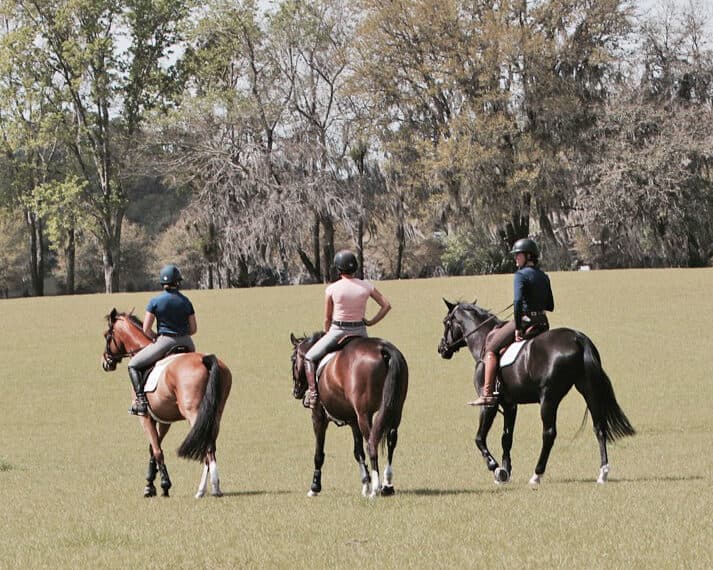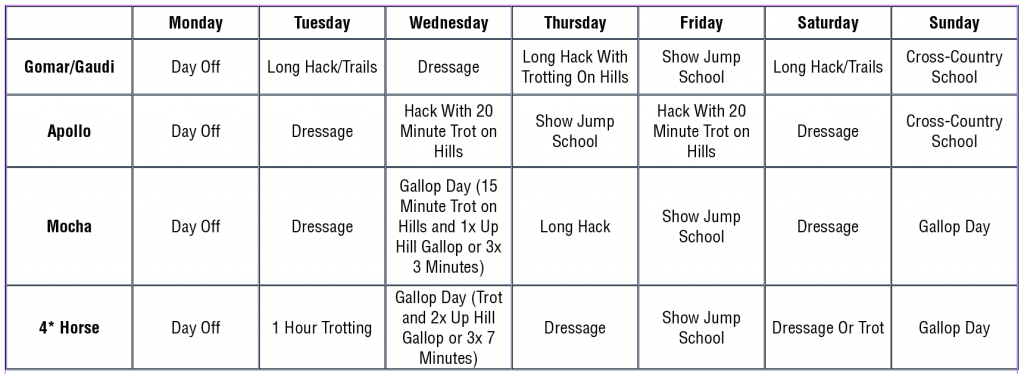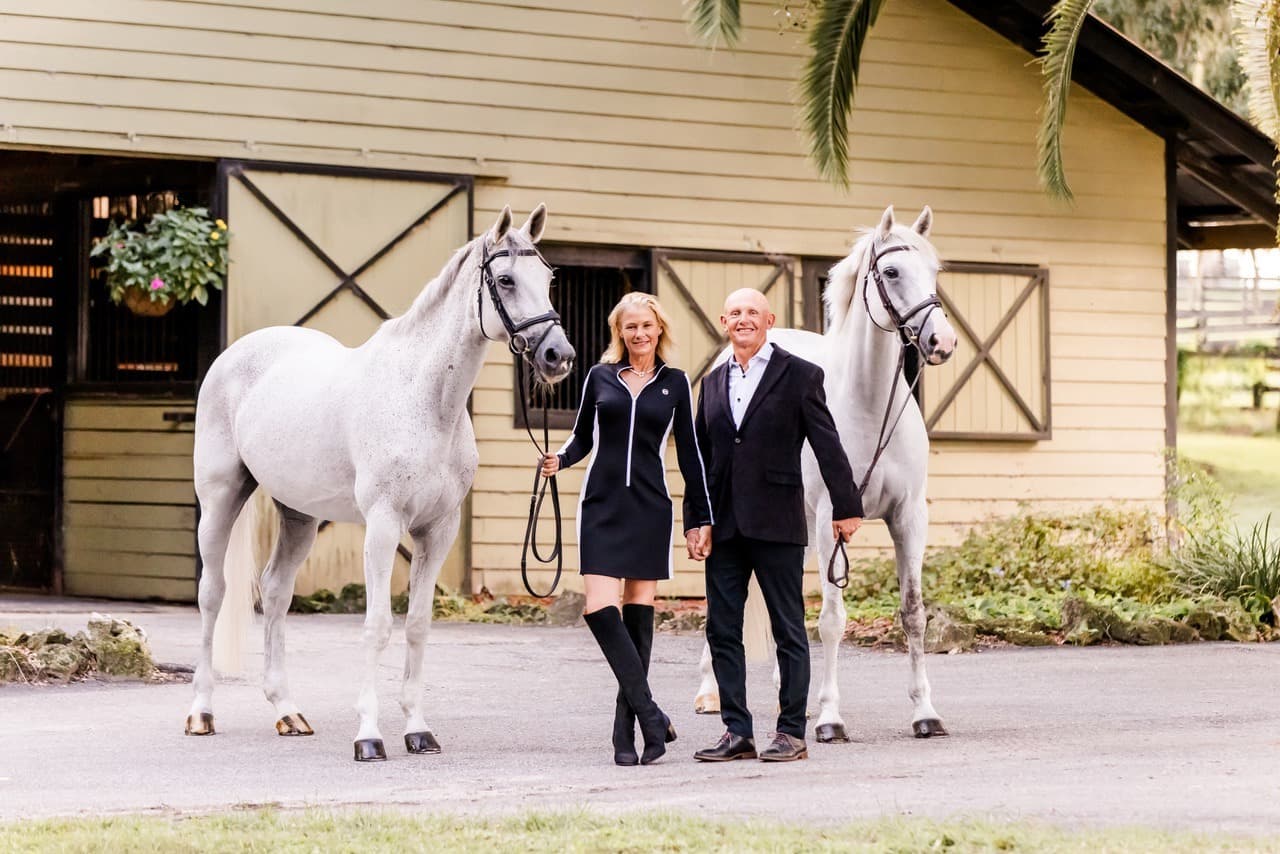Young Horses Take Their Own Courses: Focusing on Fitness

Two-time USEA Lady Rider of the Year, Olympic and Pan-Am Games rider, Lauren Kieffer is taking the USEA along on “bringing up babies” as she shares a year in the life of four of her 6-year-olds in their journey to become top level event horses.
Well it has been a very busy month since I last updated everyone on where the four young horses are in the their journeys. After Ocala International, all the young horses shipped up north to our home base in Middleburg, Va., and then we went to two little events in Kentucky and England. Luckily I have an amazing team and they have been keeping the “kids” ticking right along while I’ve been gone.
I’ve noticed a lot of discussion about fitness going on in the cyber world, both at the lower levels and up to four-star, so I thought that with this blog I would focus on what fitness work we do and what I consider a “fit” horse for different levels.
Event horses need to be fit in two senses of the word: they need to be fit to run the distance, time and speed of their desired level. They also need to be fit for the concussion and strain of that level, or what I like to call “hardened”. The wonderful thing about eventing and horse sports now is how advanced rings and footing have become and what a high standard is asked of competitions to provide that. They certainly help keep horses sounder for longer and help prevent injuries. The flip side of that is that the horses now get less concussion in their training and less exposure to uneven surfaces and terrain.
I did not grow up in the generation of long format, but I was taught early on the importance of the fitness work that was done then, and I spent a lot of time researching and asking successful people from that time what they did to keep their horses fit, sound and in long careers. Now keep in mind, the fitness work we do, even starting at a very young age, is aimed at producing a four-star horse. If your goals are to be successful and have a great time at Novice, someday do a Training Three-Day or just to enjoy your horse with the occasional schooling show thrown in, then don’t feel that you are behind the curve if your horse isn’t doing hours of fitness a week – it's time consuming and not necessary to enjoy the lower levels. But as I said before, a big part of producing an upper level horse that can have a long career at the highest level is putting in a lot of long slow fitness work in their early years.
Now we have four horses of the same age that are at very different levels of fitness, and in two ways: 1. because of their natural body type and “blood”, and 2. because of their prior lifestyle. Mocha and Apollo were born and raised on the hills of Virginia, from the time they were born they were turned out in huge fields on steep slopes with creeks, terrain, rocks and other elements. Even so, Mocha is much “bloodier” than Apollo, and easier to get and stay fit.
Gomar and Gaudi were both born and raised in the Netherlands, which is as flat as a pancake for the most part. They also were brought up in show stables and most likely didn’t spend a lot of time outside the arena, so they would be what I would call “soft”. I can’t just take Gaudi and Gomar out on the roads and hills for an hour and trot and canter to harden them up – they would most likely be pretty lame afterwards and thats not what we want! I’m very fortunate that Ms. Mars' farm gives us access to acres and acres of hills, woods, creeks, and also fantastic arenas and schooling. So right now Gaudi and Gomar spend about two days a week focused on dressage and jump schooling, and the rest of the week they go “bushwhacking” as I call it, or basically long trail rides. I take them out in the woods and deal with whatever crosses their path, splashing through creeks, climbing over stone walls, popping over fallen trees, long walks up and down hills etc. The first few days are fairly comical, it took us about 20 minutes to convince them crossing the large bubbling creek wouldn’t wash them down the river to their deaths, they tripped over fallen branches, and stumbled up and down the hills. But to be event horses they have to learn about their own feet and balance, and they quickly have become very clever and look forward to their adventures. All of this is just as important if not more so, to prepare them for moving up to the next level in the sport, just because they can do a leg yield, jump 3’6”, and school a coffin does not mean they’re ready to move up. At the end of the day, I can canter around the ring collecting and going forward all day long, but that won’t teach them how to balance on hills, but once they learn that, cross-country becomes such an easier experience for both horse and rider, they learn to balance themselves down the hills and the rider doesn't have to hold the horse up the whole way around the course.
Mocha and Apollo are competing at a higher level then Gomar and Gaudi, so they are doing a bit more fitness work. I actually chucked Mocha out in the field and gave him a month off after Ocala International. He made the successful move up to Preliminary this spring and has jumped around all four of his competitions clear. When they are that far along and going well at a young age I think its important to give them little holidays – their bodies are still changing and they still have young brains – so rather then pounding on them I let them have a little break and they always come back feeling fresh and ready to go again. Since Mocha is competing at Preliminary he has had “gallops” incorporated into his fitness work. Apollo is still at Training level so his fitness work consists of a lot of trotting. I’ve never found the need to do gallops with the horses that are competing Training level and below, as long as they’re getting ridden 5-6 days a week they have always been plenty fit for those levels. But if you don’t have time to ride that many days a week or have very cold blooded horse or one that struggles to stay fit, then incorporating canter work into your routine is certainly a good idea.
Below I’ve created a chart that show what each horses' typical week looks like. I've also included what a week for one of the four-star horses looks like for comparison. Every program is a little different, and you have to get creative when you don’t have the luxury of a lot of open space to ride on. But at the end of the day event horses need to get out-and-about and not get stuck in an arena, we expect them to gallop flat out over undulating ground to big solid fences, so they need to experience some of that in their everyday life too. It’s a slow, methodical, time-consuming process to bring a horse from birth to four-star, but certainly one of the most rewarding too.

Sample week for Lauren Kieffer's horses.














